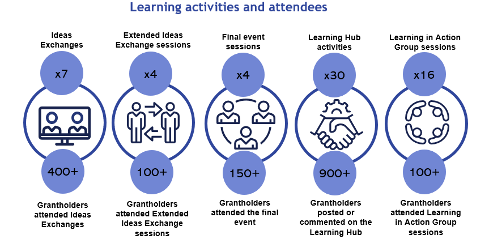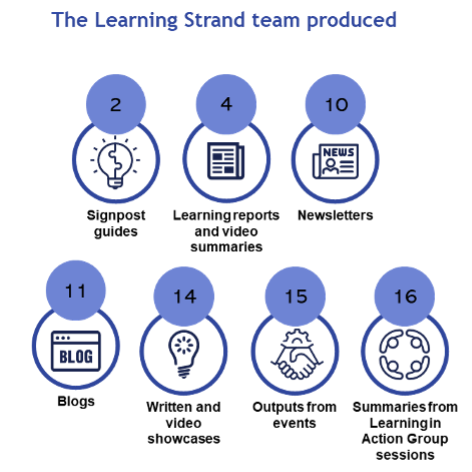The Grantholder Learning Strand of the Coronavirus Community Support Fund (CCSF) evaluation – results and learning.
COVID-19 and the associated lockdown disproportionally affected some people and communities. CCSF and National Lottery emergency funding provided grants to Voluntary, Community and Social Enterprise (VCSE) organisations in England to ensure they are able to continue helping people in need of support. In total, over £300m worth of CCSF and emergency funding grants were provided to over 11,000 charities and VCSE organisations during the pandemic. The CCSF was funded by the Department for Digital, Culture, Media and Sport and distributed by The National Lottery Community Fund (The Fund), with National Lottery emergency funding funded and distributed by The Fund.
We partnered with Ipsos MORI and New Philanthropy Capital on the process and impact evaluation to understand how the funding was distributed and what difference the funding made to organisations. The evaluation showed that CCSF helped organisations survive and continue supporting vulnerable people in their communities (find out more here). In addition to the process, impact and value for money assessment the evaluation included a Learning Strand for organisations who received CCSF or National Lottery emergency funding.
Why was the Learning Strand set-up?
COVID-19 required organisations to constantly adapt and put pressures on organisations with increased and change in demand. For this reason, the Learning Strand was set-up to give grantholders the opportunity to network, share experiences, collaborate and problem-solve together.
More specifically the Learning Strand aimed to:
- Offer a space for new connections and networks
- Develop learning activities to support grantholders to navigate through challenging circumstances
- Identify practical things organisations have done to address the challenges they have faced, effective practice and lessons learned
- Enable organisations to use the learning for their own organisations
- Share, test and debate this learning more widely
What did we deliver?
Overall, the Learning Strand was designed to share and embed learning from a major programme of crisis funding in the VCSE sector. It was a new way for The Fund to share and facilitate learning from a major programme of funding for VCSE organisations during an emergency to be delivered remotely and at speed. The Learning Strand was led by us and managed in collaboration with Ipsos MORI.
The Learning Strand was centred around the Learning Hub, an online platform for members to share experiences, connect and access resources. In total, 3,244 signed up from the 13,352 grantholder organisations invited to take part. Between October 2020 and July 2021, we designed and delivered activities of different formats to meet the diverse needs and learning preferences of a diverse audience. This included Learning in Action Groups (small, longitudinal groups focused on a theme), Ideas Exchanges (one-off Zoom events), Extended Ideas Exchanges (two longer connected Zoom sessions) and a final learning event as well as activities on the Learning Hub itself such as moderated discussion forums, polls and contests. We delivered 31 online events and sessions to over 750 participants and over 30 Learning Hub activities.
Participants enjoyed the online events and the opportunities they provided for networking, sharing of experiences and learning from each other and from speakers. They gained new knowledge, planned to implement learning in their organisations and felt part of something bigger.
“[I] acquire[d] lots of knowledge and understanding through the networking opportunities from the Hub. It has prompted a lot of skills in our organisation.” Grantholder

Learning from the different activities contributed to a range of outputs such as showcases (snapshots of the work of a particular organisation), signpost guides (summaries of key resources) and blogs from learning events. These aimed to share learning in real-time to support grantholders in challenging circumstances. Outputs were available on the Learning Hub and so also aimed to increase grantholders’ engagement with the online platform.
“The learning outputs shared have helped us to develop with confidence some of the methods used by other groups to engage their communities or service users.” Grantholder

Core outputs also included four thematic reports which summarise grantholders’ key learning. These have also been presented in form of animations.
- Creating a culture of wellbeing to support staff and volunteers (see report and animation): The pandemic put a spotlight on the importance on staff and volunteer wellbeing. The report and animation explore what helped grantholders to create a ‘wellbeing culture’ and promote wellbeing.
- Building connections based on trust (see report and animation): The pandemic changed how grantholders connected with their communities but also highlighted the important role of VCSE organisations as links to the communities. The report and animation include learning about building and maintaining connections during the pandemic.
- How the pandemic shaped volunteering (see report and animation): The COVID-19 pandemic and the restrictions resulted in changes to the way organisations worked with and supported volunteers. The report and animation include learning about the concept of volunteering during the crisis and what that means for the future.
- Building organisational resilience for the future (see report and animation): During the pandemic VCSE organisations needed to anticipate, respond and adapt to the disruption caused by the pandemic, while also planning for an uncertain time ahead. The report and animation share what grantholders have learned about preparing for the future.
What have we learnt?
The Learning Strand was a new way of engaging grantholders at scale and to offer an online Learning Hub with no key thematic focus. The COVID-19 pandemic also provided a challenging context with no face-to-face activities possible. Given the test and learn approach and iterative nature of the Learning Strand there are several lessons learned for similar initiatives (see the Learning report for more details):
- Working closely with key stakeholders and having one common vision (e.g., achieved through a Theory of Change workshop) can support the collective development of the Learning Strand.
- Building in time for reflection and for making sense of information, is essential when working in real-time and at pace.
- Understanding grantholder learning needs is crucial to ensure that some activities can be targeted to specific needs and interests at the out-set.
- A Learning Strand with multiple objectives and diverse members requires a range of different but inter-related activities.
- Building a learning community from scratch and introducing a new technology requires planning for longevity and sustainability.
- Maximising insightful learning and real-time reflection benefits from considering the ‘match’ between outputs and activities.
Further reading
Project team
- Giorgia Iacopini
- Kerstin Junge
- Georgie Parry-Crooke
- Anna Sophie Hahne
- Elyce Cole
- Heather Stradling
- Anne Benson
- Becki Skittrall
- Cassandra Lovelock
- David Drabble
- Emily Kyte
- Francis Clay
- Juliet Scott
- Kari P Hadjivassiliou
- Meg Davies
- Rachel Kelly
- Richard Allen
- Sam Nightingale
